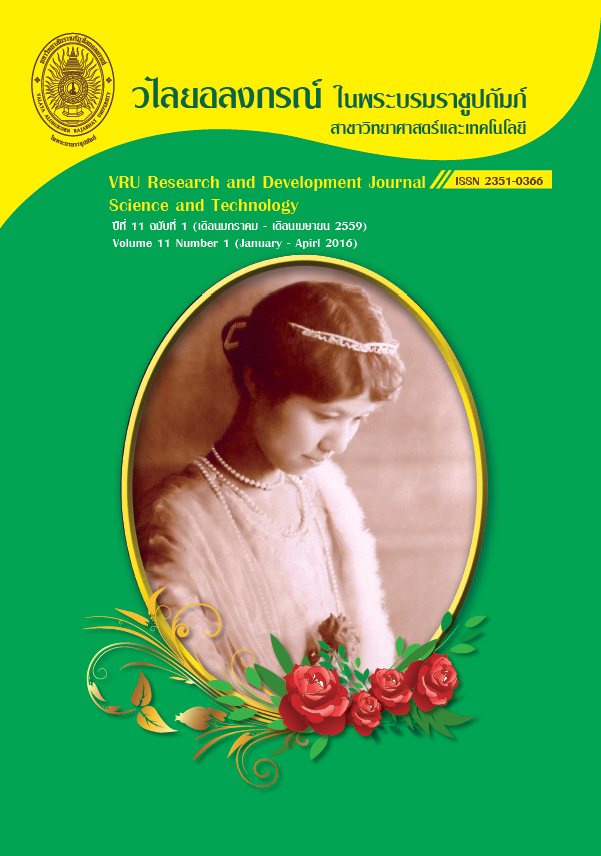การศึกษาฤทธิ์ต้านแบคทีเรียของสารสกัดจากวัชพืชบางชนิด
Main Article Content
Abstract
งานวิจัยนี้เป็นการศึกษาผลของสารสกัดจากส่วนต้นและดอกของกกรังกา และส่วนรากและใบของผักตบชวา ต่อการออกฤทธิ์ยับยั้งการเจริญของแบคทีเรีย 3 ชนิด ได้แก่ Staphylococcus aureus Bacillus subtilis และ Escherichia coli โดยใช้วิธีการสกัดแบบแช่ยุ่ย (marceration) โดยตัวทำละลาย 4 ชนิด คือเฮกเซน , ไดคลอโรมีเทน , เอทานอล และเมทานอล การศึกษาฤทธิ์ในการยับยั้งการเจริญของแบคทีเรียทั้ง 3 ชนิด ของสารสกัดหยาบจากกกรังกาและผักตบชวาใช้วิธี disk diffusion techniques จากการศึกษาพบว่า สารสกัดดอกกกที่สกัดด้วยเอทานอลมีฤทธิ์ในการยั้บยั้งการเจริญของ Bacillus subtilis ได้ โดยมีเส้นผ่านศูนย์กลางของบริเวณยับยั้งเฉลี่ยเท่ากับ 12 มิลลิเมตร และสารสกัดหยาบจากต้นกกรังกาที่สกัดด้วยเอทานอล มีฤทธิ์ในการยับยั้งการเจริญของแบคทีเรีย Bacillus subtilis ได้ดีที่สุด รองลงมาคือ Staphylococcus aureus โดยมีขนาดเส้นผ่านศูนย์กลางของบริเวณยับยั้งเฉลี่ยเท่ากับ 9.3 และ 8.0 มิลลิเมตร ส่วนสารสกัดหยาบจากผักตบชวาไม่มีฤทธิ์ในการยับยั้งการเจริญของแบคทีเรียทั้ง 3 ชนิดที่ใช้ทดสอบ การทดสอบหาค่าความเข้มข้นต่ำสุด (Minimal Inhibitory Concentration, MIC) ของสารสกัดหยาบจากดอกกกรังกาที่สกัดด้วยเอทานอลด้วยวิธี Macro broth dilution technique ในการยับยั้งการเจริญของ Bacillus subtilis ได้ค่าเท่ากับ 25 มิลลิกรัมต่อมิลลิลิตร สำหรับค่าความเข้มข้นต่ำสุดของสารสกัดหยาบจากต้นกกรังกาที่สกัดด้วยเอทานอล ในการยับยั้งการเจริญของแบคทีเรียทั้ง Bacillus subtilis และ Staphylococcus aureus คือ 6.25 มิลลิกรัมต่อมิลลิลิตร แต่เมื่อทดสอบค่าความเข้มข้นต่ำสุดที่สามารถฆ่าแบคทีเรียได้ (Minimal bactericidal concentration, MBC) ของสารสกัดหยาบจากต้นกกรังกาที่สกัดด้วยเอทานอลต่อแบคทีเรียทั้ง Bacillus subtilis และ Staphylococcus aureus คือ 25 มิลลิกรัมต่อมิลลิลิตร
This research studied the effects of the crude extracts from the stems and the flowers of the Cyperus alternifolius L. and the roots and the leaves of the water hyacinth to inhibit the growth of three species of Staphylococcus aureus, Bacillus subtilis and Escherichia coli. Hexane, dichloromethane, ethanol and methanol were used as the extraction solvents. Antibacterial activities on three bacteria were tested by using disk diffusion technique. Result showed that the ethanol crude extract from the flowers of Cyperus alternifolius L. could inhibit Bacillus subtilis with the inhibition zone of 12 mm. The ethanol crude extract from the stems of Cyperus alternifolius L. exhibited the highest activity against Bacillus subtilis, followed by Staphylococcus aureus, with the inhibition zone of 9.3 and 8.0 mm, respectively. While the extracts from the water hyacinth has no inhibited the growth of all three species. To test the MIC (Minimal Inhibitory Concentration) of the ethanol crude extracts from the flowers and the stems of Cyperus alternifolius L. by using Macro broth dilution technique. The result showed that the MIC of the ethanol crude extracts from the flowers of Cyperus alternifolius L. against Bacillus subtilis is 25 mg/ml. Where as the MIC of the ethanol crude extracts from the stems of Cyperus alternifolius L. against the both of Bacillus subtilis and Staphylococcus aureus were 6.25 mg/ml. While the MBC (Minimal bactericidal concentration) of the ethanol crude extracts from the stems of Cyperus alternifolius L. against the both of Bacillus subtilis and Staphylococcus aureus were 25 mg/ml.
Downloads
Article Details
Copyright Notice
The copyright of research articles published in the VRU Research and Development Journal Science and Technology Journal belongs to the Research and Development Institute, Valaya Alongkorn Rajabhat University under the Royal Patronage. Reproduction of the content, in whole or in part, is prohibited without prior written permission from the university.
Responsibility
The content published in the VRU Research and Development Journal Science and Technology Journal is the sole responsibility of the author(s). The journal does not assume responsibility for errors arising from the printing process.
References
เกลายุคล สุจิรา. (2547). ผลของสารสกัดจากธูปฤาษี (Typha angustifolia Linn.) ตอการเจริญของพืช และการยับยั้งของเชื้อราสาเหตุโรคพืช. กรุงเทพฯ: มหาวิทยาลัยเกษตรศาสตร.
เกษร นันทจิต, ชนกพร เผ่าศิริ, จันทนา คำวรรณ, บรรยง คันธวะ, มนัสนันท์ บุญชู, สมพร ภูติยานันต์. (2544). ฤทธิ์ต้านจุลชีพของใบขันทองพยาบาท. กรุงเทพมหานคร : สำนักงานคณะกรรมการวิจัยแห่งชาติ.
จันทนา กาญจน์กมล, รินรดา พรมศิริ และ รัชนก เขื้อเดชะ. (2005). การต้านเชื้อแบคทีเรียของสารสกัดจากหน่อกะลา. 31st congress on science and technology of Thailand at Suranaree university of technology, 18-20 October 2005. [online] http://www.scisoc.or.th/stt/31/sec_b/paper/stt31_B0082.pdf.
นงลักษณ์ สุวรรณพินิจ และ ปรีชา สุวรรณพินิจ. (2541). จุลชีววิทยาทั่วไป. กรุงเทพฯ : จุฬาลงกรณ์มหาวิทยาลัย.
นภัสวรรณ์ หัตถกิจพาณิชกุล และ จันทร์เพ็ญ ตั้งจิตรเจริญกุล. การสกัดสารจากใบกระเบาเพื่อยับยั้งการเจริญของเชื้อโรคพืช Xanthomonas campestris และ Fusarium oxysporum.
[online] http://www.scisoc.or.th/stt/32/sec_o/paper/stt32_O2_O0020.pdf.
นุจารี ประสิทธิ์พันธ และพิศทุธิ์ เอกกานตรง. (2527). การแยก การทําใหบริสุทธิ์ และการศึกษา องคประกอบทางเคมีของผกัตบชวา. รายงานผลการวิจยัประจําป 2527, มหาวิทยาลัยเกษตรศาสตร.
สุภาพร พงษ์มณี และกัญณาญาภัค สนามพล. (2550). การสกัดสารจากพืชสมุนไพรเพื่อยับยั้งแบคทีเรียก่อโรคในอาหาร. วารสารวิทยาศาสตร์เกษตร, 38(6), 54-57.
อาริยะ ไชยสวัสดิ์ ประสาท กิตตะคุปต์ และสุชาดา ไชยสวัสดิ์. (2550). การศึกษาฤทธิ์ยับยั้งเชื้อโรคเบื้องต้นของสารสกัดจากใบกระทิง. การประชุมวิทยาศาสตร์และเทคโนโลยีแห่งประเทศไทย ครั้งที่ 33.


